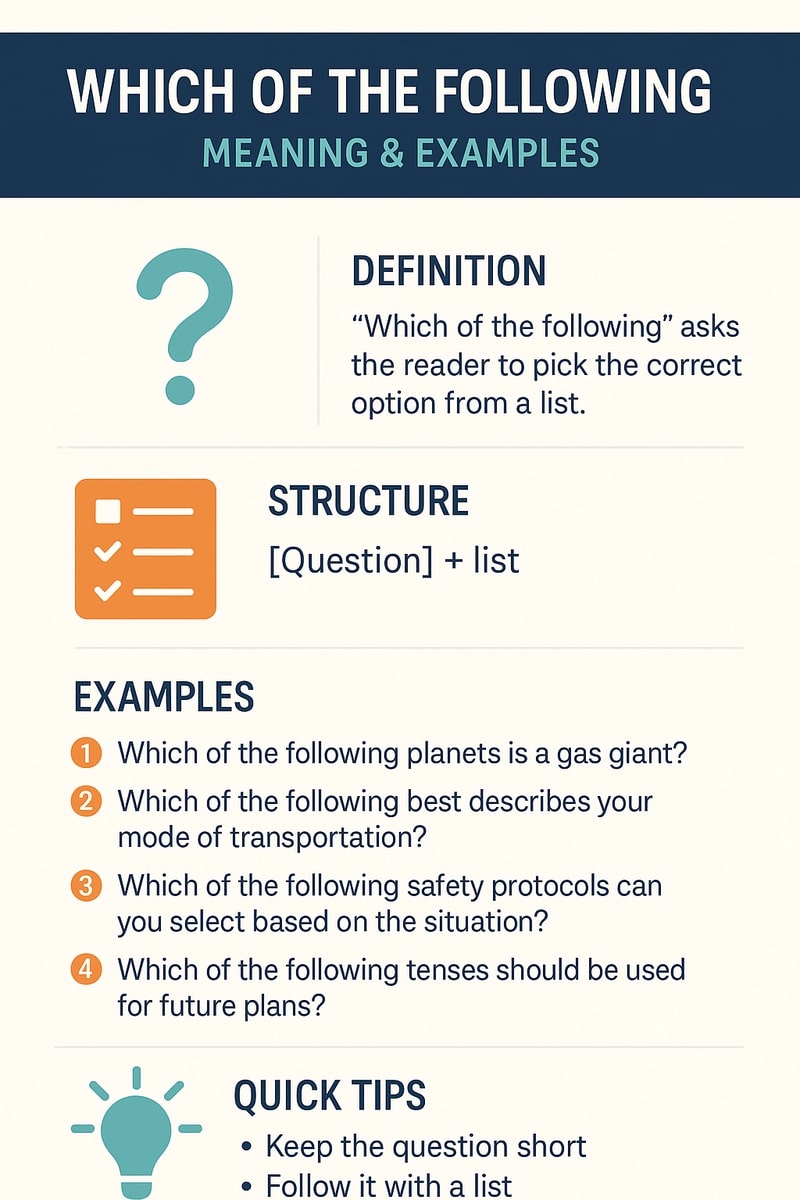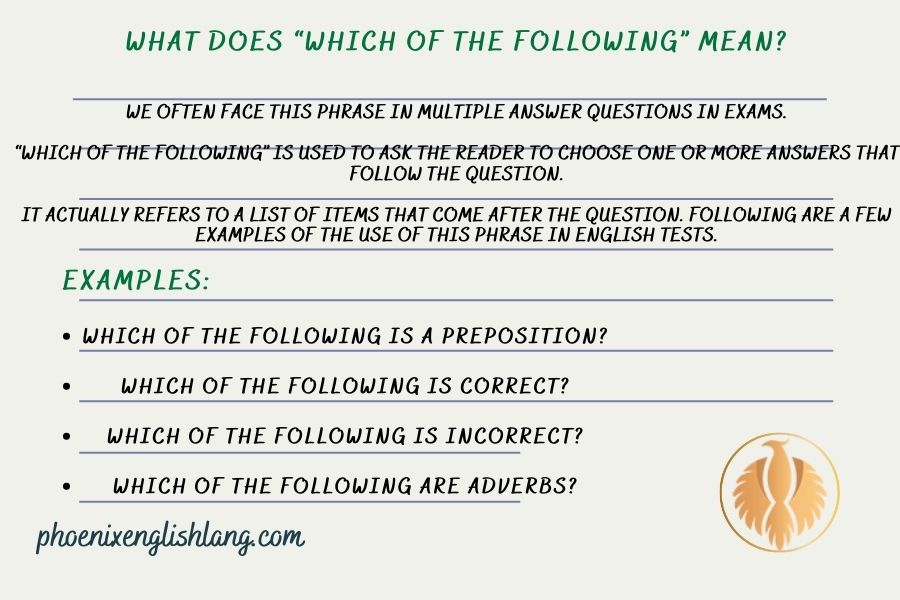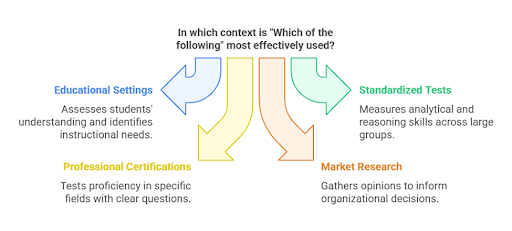Which of the following is a testing phrase that asks the reader to choose the correct option(s) from the list that comes right after the question. In multiple-choice exams, it functions as an interrogative determiner and always refers forward, never back.
Here are some examples:
- Which of the following best describes your primary mode of transportation?
- Which of the following approaches should be chosen depending on the situation?
- Which of the following tenses should be used for future plans?

Definition of “Which Of The Following”
So what does “which of the following” mean? The phrase “Which of the following” prompts a choice from a list of options, directing the reader to evaluate and select the correct or relevant answer. Often used in quizzes and instructions, it simplifies decision-making by presenting a structured set of choices to consider.
This phrase is commonly found in multiple-choice questions, where it serves to direct the reader’s attention to the options that follow.
For example, in a multiple-choice test, you might encounter a question like:
“Which of the following is the capital of France?
a) Berlin
b) Madrid
c) Paris
d) Rome”
In this context, the phrase “Which of the Following” asks the reader to select the correct answer from the list of options.
Complete Usage Of “Which Of The Following”
Understanding the complete usage of “Which of the Following” involves recognizing its role in various contexts, particularly in educational and assessment settings. Here are some key points to consider:
1. Multiple-Choice Questions: This phrase is most used in multiple-choice questions, where it helps to frame the question and guide the reader towards the options provided. It is essential to ensure that the reader understands they need to choose from the given list.
2. Surveys and Polls: “Which of the Following” is also used in surveys and polls to gather specific information from respondents. For example, a survey might ask, “Which of the following best describes your primary mode of transportation?” followed by a list of options such as car, bus, bicycle, and walking.
3. Quizzes and Exams: In quizzes and exams, this phrase helps to structure questions clearly and concisely. It ensures that the test-taker knows exactly what is being asked and can focus on selecting the correct answer from the provided choices.
4. Instructional Materials: Educational materials, such as textbooks and workbooks, often use “Which of the Following” to pose questions that reinforce learning and comprehension. This phrase helps to engage students and encourage critical thinking.
You might also enjoy: Where Does “How is your Day Going?” Originate From?
Grammar Rules
The phrase “Which of the Following” follows specific grammatical rules that ensure its correct usage in sentences. Keep these important points in mind:
1. Subject-Verb Agreement: The phrase “Which of the Following” is typically followed by a singular verb, as it refers to one correct option among the lists. For example, “Which of the following is the correct answer?” Here, “is” agrees with the singular subject “Which.”
2. Punctuation: When using this phrase in a question, it is important to follow it with a question mark. For example, “Which of the following is true?” This punctuation helps to indicate that a question is being asked.
3. Capitalization: In formal writing, the first word of the phrase “Which of the Following” should be capitalized if it begins a sentence.
4. Contextual Clarity: Ensure that the options provided after the phrase are listed and distinct. This clarity helps the reader to easily understand and choose the correct answer.
By understanding the definition, complete usage, and grammar rules of the phrase “Which of the Following,” we can enhance our ability to use it correctly in different contexts.
This phrase is a valuable tool in educational and assessment settings, helping to structure questions and guide readers toward the correct answers. Whether you are creating a test, conducting a survey, or writing instructional materials, knowing how to use “Which of the Following” effectively will improve your communication and ensure clarity in your questions.
Don’t miss our new video about Which of the Following – watch now!
What Does “Which Of The Following” Mean?

We often face this phrase in multiple-choice questions in exams.
“Which of the following” is used to ask the reader to choose one or more answers that follow the question.
It actually refers to a list of items that come after the question. Following are a few examples of the use of this phrase in English tests.
How to use “which of the following”?
“‘Which of the following’ is a phrase used to introduce a list of options or choices from which the respondent needs to select one or more that meet a specific criterion. It’s commonly used in questions to prompt the selection of the correct or most appropriate answer.”
“Let’s look at how ‘Which of the following’ is used in different scenarios. This phrase is often found in multiple-choice questions in exams, quizzes, and surveys. Here are some examples:
In a science test: ‘Which of the following elements is a noble gas?’
- a) Oxygen
- b) Nitrogen
- c) Argon
- d) Hydrogen
In a history quiz: ‘Which of the following events occurred first?’
- a) The signing of the Magna Carta
- b) The American Revolution
- c) The French Revolution
- d) The Industrial Revolution
In each example, the phrase ‘Which of the following’ introduces a set of choices, and the respondent must select the one that best fits the question’s criterion.”
Importance Of “Which Of Following” in Different Contexts

Educational Settings: Teachers use “Which of the following” to craft questions that accurately assess students’ understanding of the material. This helps in evaluating the grasp of concepts and identifying areas where further instruction is needed.
Standardized Tests: Examination bodies, such as those responsible for the SAT, GRE, and GMAT, employ this format to test candidates’ analytical and reasoning skills. It ensures a standardized approach to measure performance across a large number of examinees.
Professional Certifications: Certification exams often require precise assessment of knowledge. Using “Which of the following” provides a clear and structured way to test candidates’ proficiency in their respective fields.
Market Research: Surveys and polls use this phrase to gather opinions and preferences from respondents. It helps organizations understand their audience’s needs and make informed decisions based on the data collected.
You might also enjoy: What Kind of Vs What Kinds of – Differences + Examples [2025]
Should I use is or are with which of the following?
The choice between “is” and “are” when using “Which of the following” depends on whether you are referring to a singular or plural noun. Here’s a clear guide:
Using “Is”
– Use “is” when the noun you are referring to is singular.
– Example: “Which of the following books **is** your favorite?”
– “Books” is plural, but you are asking about one specific favorite book, so “is” is correct.
Using “Are”
– Use “are” when the noun you are referring to is plural.
– Example: “Which of the following statements **are** true?”
– “Statements” is plural, and you are potentially asking about more than one statement, so “are” is correct.
Is it correct to use “which of the followings”?
The answer is a strict ‘No’. That is because “the following” means “the next”, so it can not be pluralized.
Actually, “following” is an ‘adjective’ and we cannot make adjectives plural. Let’s take the example of “sunny” as an adjective.
We can never make it plural and say “sunnies”. Therefore, “which of the following” is always used in this fixed way.
“Which of the following is” or “which of the following are”?
Actually, both are correct, but there are important grammatical points to consider about each of them.
When we use a singular verb after “the following”, we are asking the reader to choose ‘only one answer’ from the list of options. Look at the following examples to understand this better.
You might also enjoy: How Are You Fairing or Faring? Differences + Examples
Can we use “which of the below” instead?
Well, the phrase “which of the below” is grammatically incorrect. That is because ‘below’ is an adverb.
However, there is one way to use ‘below’ in this phrase. We need to add a plural noun before ‘below’. Take a look at the following example to get this better.
Synonyms for “which of the following”

So, let’s learn some other phrases you can use instead of “which of the following”.
- Which of the (plural noun) below
- Which of these (plural noun, e.g., options/ items)
- Which one
- Which answer
- How many of these (plural noun)
- How many of the following (plural noun)
- Can you name the
- Are there any here that
You might also enjoy: That vs Which | Correct Usage + 2025 Examples
Concluding note
So, today I tried to teach you all you need to know about ‘which of the following”. I told you about its meaning and usage.
Now that you have learned everything about this subject, go on to make your own multiple-choice questions and lists of answers.
I’m sure you are now ready to do this. Make sure to contact me here on this page to ask your questions. I will be ready to answer and guide you. Visit my page for more interesting English lessons!

Hi, welcome to my blog! My name is Omid and I am thrilled to have you here! I am an English language teacher with 12 years of experience and hold multiple international certifications (TESOL, IELTS, TOEFL, PTE, CELTA). Additionally, I hold a PhD in Applied Linguistics with a specialization in Teaching English as a Second Language (TESL), which fuels my passion for teaching English and assisting others in mastering the language. To me, nothing is more rewarding than helping individuals enhance their English language abilities through various methods. So, let’s embark on this journey of learning English together.





2 Comments
Thanks for sharing. I read many of your blog posts, cool, your blog is very good.
I really enjoyed this article! I guess this the most complete article I have ever read about “which of following”
Thanks Omid and keep up the good work!